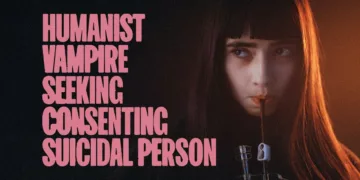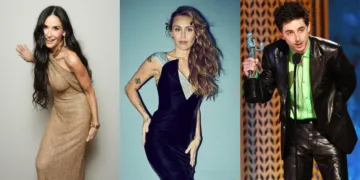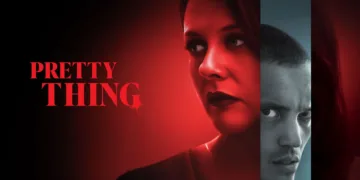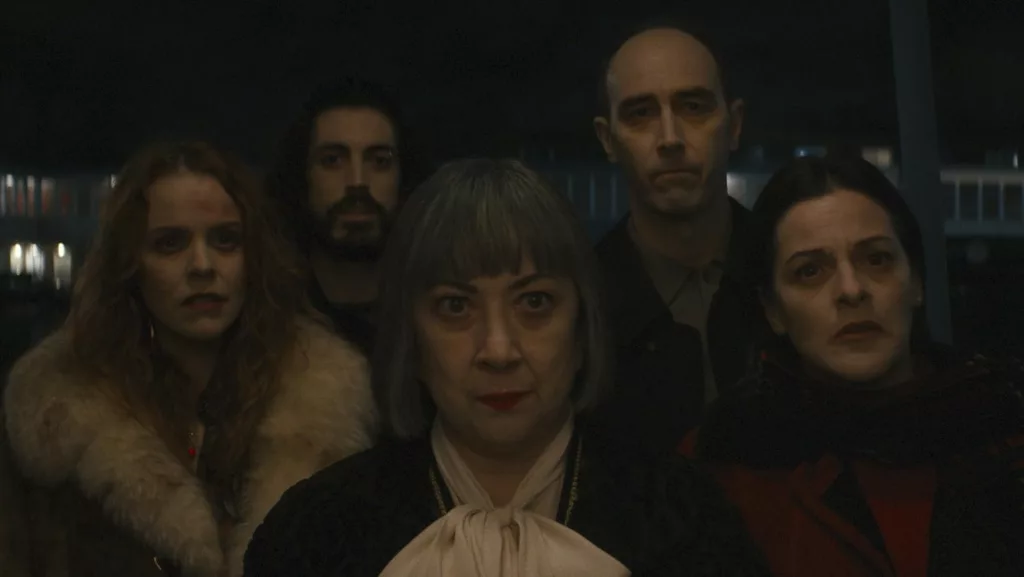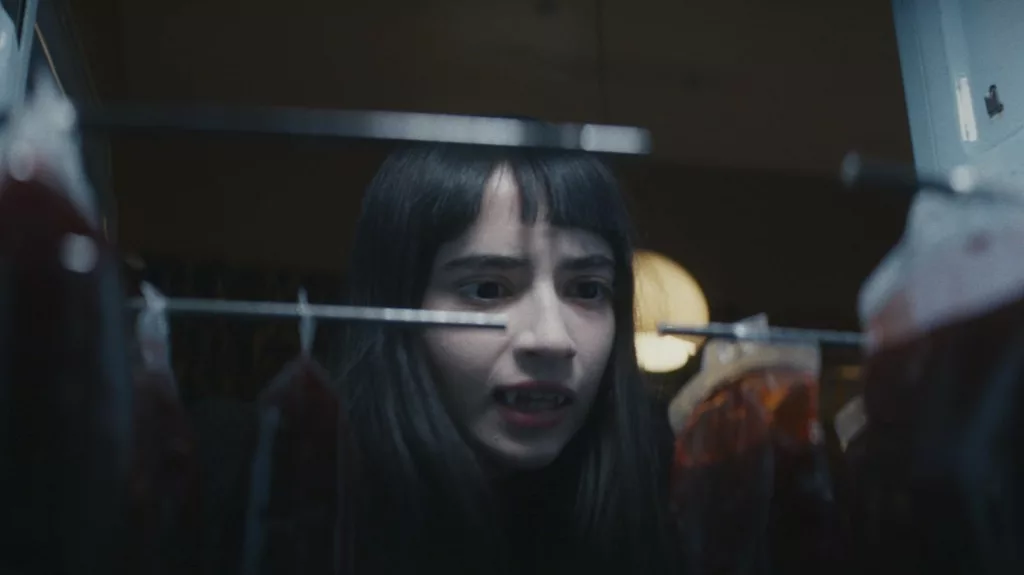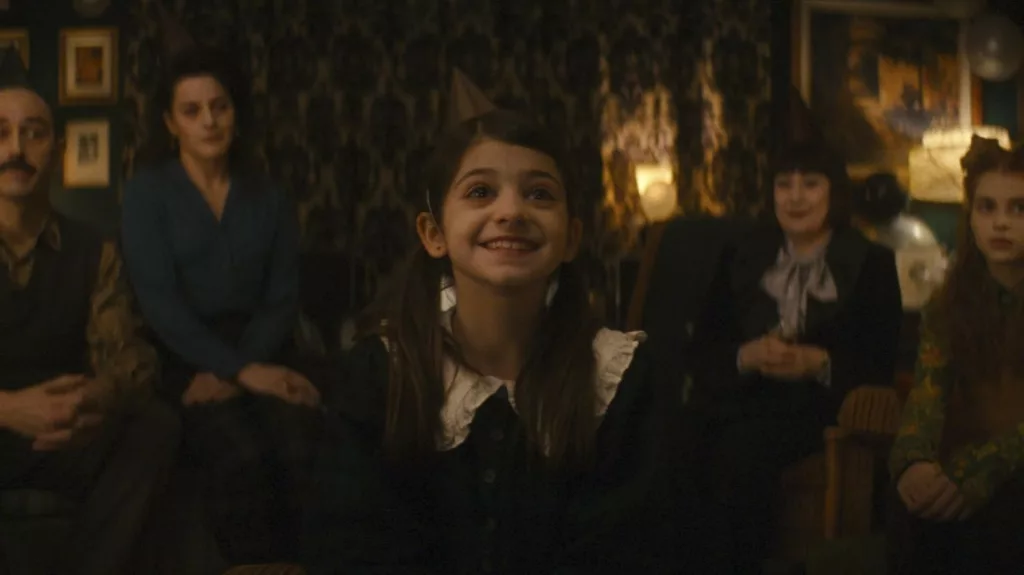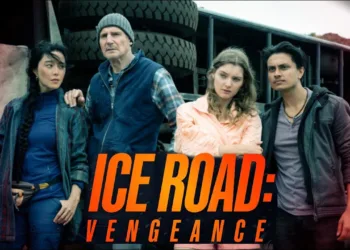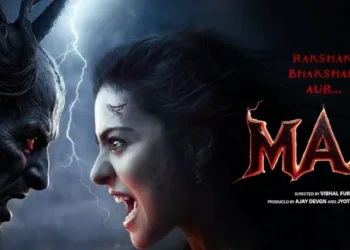Rising Fangsist Vampire Seeking Consenting Suicidal Person introduces us to a group unlike any other. Director Ariane Louis-Seize takes us into the world of vampires living in suburban Quebec, crafting an offbeat story full of heart. We meet Sasha, a vampire struggling with her innate needs due to her unusual empathy. Played vibrantly by Sara Montpetit, Sasha shrinks at the thought of feeding yet still longs for blood.
When her parents cut her off for refusing to hunt, Sasha wanders to help group meetings, seeking another way. There she encounters Paul, a lonley teen played sensitively by Félix-Antoine Bénard, contemplating his own end. Their meeting sparks an unexpected bond between two outsiders. Through Sasha and Paul’s growing friendship, Louis-Seize explores what it means to find belonging among society’s misfits.
With a lively supporting cast, including Noémie O’Farrell’s scene-stealing cousin Denise, the film brings this offbeat community to humorous life. But Louis-Seize finds empathy in even the macabre, handling dark themes of suicide and identity with nuanced care. Through Sasha’s eyes, we see a world where fitting in means leaving your humanity behind. Her dilemma over satisfying innate needs while keeping her compassionate heart symbolizes the challenge of individualism.
Underneath the fun glimpses into vampire parenting and quirky small town life lies a deeper examination of finding one’s place in the world. With wit and sensitivity, Louis-Seize and an impressive debut cast offer an endearing perspective on feeling different and searching for where you truly belong.
Origins of Empathy
Humanist Vampire Seeking Consenting Suicidal Person tells the story of Sasha, a young vampire struggling with her innate need for blood. Unlike her family, killing humans doesn’t come naturally to Sasha—an incident as a child left her deeply troubled by violence.
Now in her late teens, Sasha still lives at home and relies on her parents for blood. But they grow impatient with her reluctance to hunt for herself. Hoping her cousin Denise can toughen her up, Sasha moves in with her hipper relative.
Around this time, Sasha notices Paul, a sullen boy often spotted at the edge of rooftops. When their paths cross again at a suicide prevention group, they strike up an unexpected bond. Paul offers to let Sasha feed from him, solving both their problems.
But over time, Sasha’s appetite for blood conflicts with her conscience. She seemingly prefers Paul’s company to violent feeds, a troubling dilemma for a vampire. Meanwhile, Paul, an outcast bullied by all, finds solace in perhaps the one person who understands his loneliness.
The film explores what’s underneath Sasha’s aversion to killing through thoughtful scenes of empathy. Sara Montpetit portrays Sasha’s demeanor as outwardly dour yet inwardly sensitive, deeply feeling the emotional and moral complexity of her nature. Her character represents society’s misfits, who don’t quite fit in anywhere.
In contrast, Félix-Antoine Bénard imbues Paul with a certain calm despite his pain, a quiet soul resonating with Sasha’s. Through his character, the story poses philosophical questions about life, death, and what truly makes one human or inhuman. Their bond forms the heart of the tale.
While the plot follows a familiar coming-of-age structure, director Ariane Louis-Seize infuses it with imaginative social commentary through Sasha’s vampire world. The film delves beneath stereotypes to uncover deeper truths about individualism, morality, and finding belonging against all odds.
Distinctive Direction
Ariane Louis-Seize brings a keen vision to a humanist vampire seeking consent to suicidal behavior. Her background in television is clear; she expertly balances multiple tones throughout the film.
From the offbeat opening, Louis-Seize establishes a quirky comedy. A hapless clown endures vampires snacking on his flesh as a bemused Sasha looks on. It’s a macabre joke that sets the tone with a black yet playful tone.
Louis-Seize directs with assured flair. Scenes are composed and lit to accentuate character perspectives. When Sasha’s inner turmoil rises, the frame closes in with shadows. But her growing bond with Paul opens up, reflected in the warmer lighting of their intimate moments.
Subtle touches enhance this world. Vampires’ pale complexions and dark under-eyes hint at a supernatural life beneath normal routines. Sound design too breathes life, from the scratch of vinyl enhancing quiet scenes to screeches piercing tense moments.
While the story follows familiar coming-of-age beats, Louis-Seize’s distinctive style keeps viewers engaged. She layers complex themes within entertaining sequences, whether Sasha and Paul’s misadventures or family confrontations laden with dry wit.
Her direction carefully balances the heavier subject matter. Sasha’s plight brings drama as she fights nature, yet the film avoids brooding tones through quirky supporting players. Paul’s backstory adds pathos but is delivered amidst amusing moments that spare melodrama.
Throughout, Louis-Seize shows deft control of pace and performance. The result is a genre-blending film that effortlessly shifts between comedy, drama, and touches of horror, merging them into a cohesive whole with mass appeal.
Viewers constantly guess where the tone will veer next, a testament to Louis-Seize’s unpredictable yet skillful handling behind the camera. Her distinctive directorial command brings this outsider story vividly to life.
Identity and Individuality
Humanist Vampire Seeking Consenting Suicidal Person tackles some weighty themes through its quirky story. At its heart, it’s a tale of self-discovery and forging one’s own path.
Sasha bucks expectations placed on her kind. As a vampire, she’s meant to hunt humans without remorse. Yet her sensitive nature prevents this. Sasha struggles with her identity—is she too weak for her nature or brave for following her heart?
Her journey parallels real-world issues of discovering who you are. Many face pressure to conform and are questioned for being “different.” The film sympathizes with Sasha’s dilemma and her parents’ confusion, making it feel authentic.
Sasha also finds solace in an unlikely friend. Paul, too, feels like an outsider among his peers. Their bond forms through understanding each other, not despite differences.
Louis-Seize shows individuality is a strength, not a flaw. Sasha and Paul help one another embrace traits others may shun. By the story’s end, both accept themselves wholly for the first time.
The director handles this poignantly. Nuanced performances show inner turmoil giving way to pride in one’s identity. Simple acts, like dancing together, portray the joy of being fully oneself with another.
Not everything is neatly resolved, mirroring life’s complexities. But the film instills hope that we can chart our own course and find belonging if we are true to our nature. It celebrates self-definition over conformity to expectations.
In doing so, it brings levity to weighty issues of morality and individualism that still resonate. Through fanciful fang tales, Louis-Seize crafts an empowering allegory for being true to one’s self.
Captivating Characters
At the heart of Humanist Vampire are the characters and the actors who bring them to life. Sara Montpetit owns the role of Sasha, capturing her complexity with subtlety and depth. Sasha treads a fine line: pacifist vampire, reluctant killer, sensitive teen exploring herself. Montpetit navigates these dimensions masterfully. Her wide eyes and cautious manner convey Sasha’s gentle nature, while flashes of confidence hint at her prowess below the surface.
Paul, too, faces an identity crisis of sorts. Felix-Antoine Bénard excels as the bullied boy searching for purpose. Beyond Paul’s morose musings lies a quick wit, and Bernard plays both sides vibrantly. Scenes of the pair connecting feel genuine thanks to their natural chemistry. As Sasha and Paul learn to embrace who they are, the actors draw us wholly into their journey.
Supporting roles are no less compelling. Noémie O’Farrell stands out as cousin Denise, a stark contrast to Sasha, yet Written with care, these multi-layered characters and the performances that shape them remain long after the credits roll.
Captivating Creations
From its moody cinematography to its inventive production design, Humanist Vampire draws viewers into its unique world. Behind the camera, DoP Shawn Pavlin crafts Parisian streets and snowy alleys with inky shadows and luminous interiors. His lighting immerses us in Sasha’s perspective, with flashes of color highlighting her emotions.
Complementing this atmosphere is superb work from the Art Department. Sasha’s family home feels chicly lived-in yet shadowy. Sparse details, like blood pouches in the fridge, reveal lifestyle quirks. Cousin Denise lives in loft-style splendor, contrasting Sasha’s gentler qualities. Together, these locales anchor us in the vampires’ reality.
Enhancing the visuals further is the evocative soundtrack. With songs like “Emotion” and Dracula Ye-Ye, music plays a bonding role for Sasha and Paul and reveals their shy energies. Original songs augment key moments, pulling heartstrings during a pivotal dance scene.
Though it deals with the macabre, the film’s technical ingenuity downplays horror aspects. It prioritizes atmosphere over shocks, weaving us delicately into these protagonists’ worlds. Even minor elements, like realistic fangs and makeup, reinforce the alternate society at the story’s heart.
Together, these considered technical contributions forge an enveloping gothic realm. They breathe life into the offbeat premise and allow viewers to fully immerse themselves in Sasha’s poignant coming-of-age journey.
The Review
Humanist Vampire Seeking Consenting Suicidal Person
Ariane Louis-Seize's Humanist Vampire offers a fresh and poignant twist on the coming-of-age story and vampire mythos. With empathetic characters, visual flair, and plenty of heart, it explores universal themes of identity, friendship, and first love in a way that feels singular yet welcoming. Directed with confidence and care, this charming tale proves some of the best stories can come from placing outsiders center stage and letting their journey unfold with whimsy. Though just starting her career, Louis-Seize confirms her talents with this special film that will no doubt speak to and stay with many viewers.
PROS
- Unique and intriguing premise
- Strong central performance from Sara Montpetit
- Visually striking with creative world-building
- Touches on universal themes of identity, friendship, and coming-of-age in a relatable way.
- Blends humor, heart, and fanciful elements quite well.
- Director Ariane Louis-Seize shows promise
CONS
- The narrative could be tighter at times.
- May not offer much new for those seeking deeper vampire lore.
- Some may find the tone too light at moments.
